For the opportunity to review the Mir-20N 3.5 / 20 lens, many thanks to Alexander from the manual optics section.
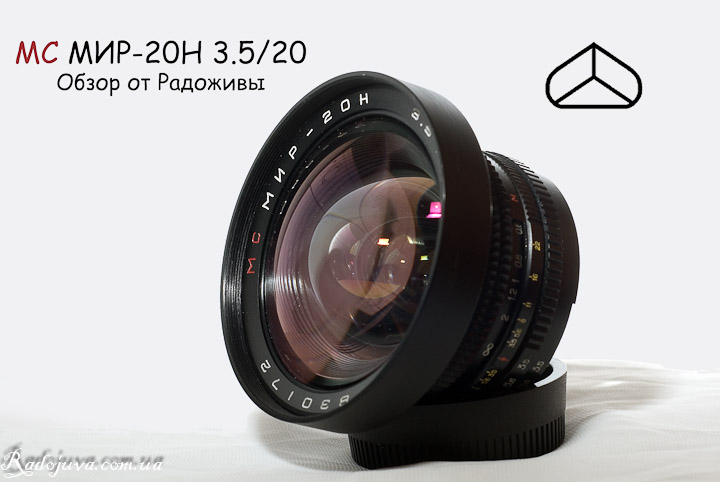
MS MIR-20N 3.5 20mm review from Radozhiva
TTX of the lens Mir-20N 3.5 / 20
- Focal Length: 20mm
- Aperture: F / 3.5-F / 22.0
- Number of aperture blades: 5 pieces
- MDF: 18cm
- Weight: about 450g
- Front Filter Diameter: 77mm
- Bayonet mount: N (Nikon F analogs, AI-S type)
Please note that the Mir-20 lens had a large number of different modifications. Basically, the differences concerned enlightenment and attachment to the camera, as well as the frame of the case.
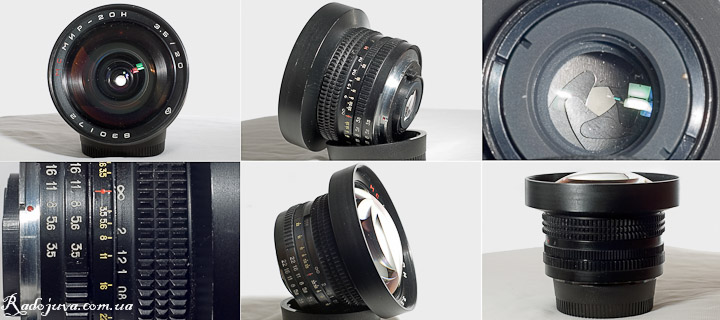
View MS Mir-20N 3.5 / 20 from different sides
There are lenses World 10, Mir-20M и MS Mir-20M with landing thread M42 and with different aperture control options. there is MS Mir-20K, for K mount (Pentax) and Mir-20-machine (from Kiev-10, -15). Mir-20 and Mir-20 are one and the same lens.
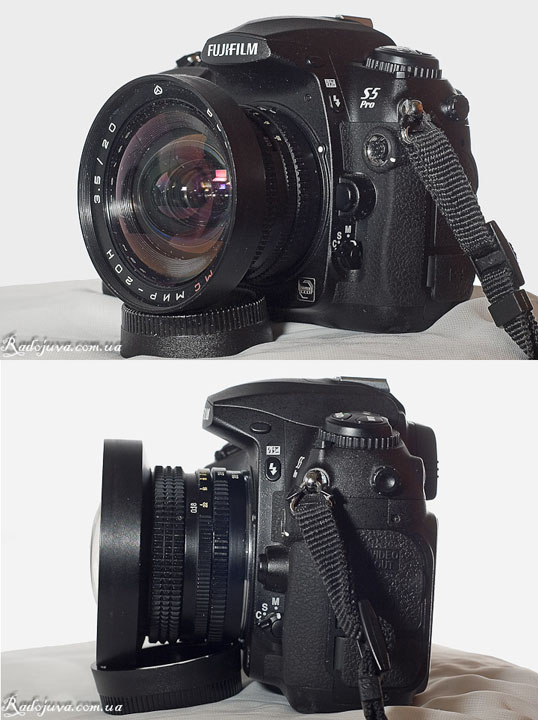
View of the Mir Mir-20N 3.5 / 20 from different sides on a modern camera
The lens presented in this review is MS Mir-20N 3.5 / 20 with multi-coating, H-mount, manufactured at the Arsenal plant, Ukraine, Kiev. The letter “H” in the lens name indicates that the lens mount (mount to the camera) is the same as the Nikon F. MS Mir-20N 3.5 / 20 is also AI-S (including AI) compatible lens for Nikon. Simply put, MS Mir-20N 3.5 / 20 can without problems and adapters immediately use on any modern Nikon digital SLR or film camera. I use MS Mir-20N on cameras Nikon D40, D80, S5 Pro. When used on modern digital SLR cameras, it will be possible to semi-automatically control the diaphragm. Measurement exposure will only work on parts of the cameras. In more detail, about how to use the old Soviet lensesread section Soviet optics.
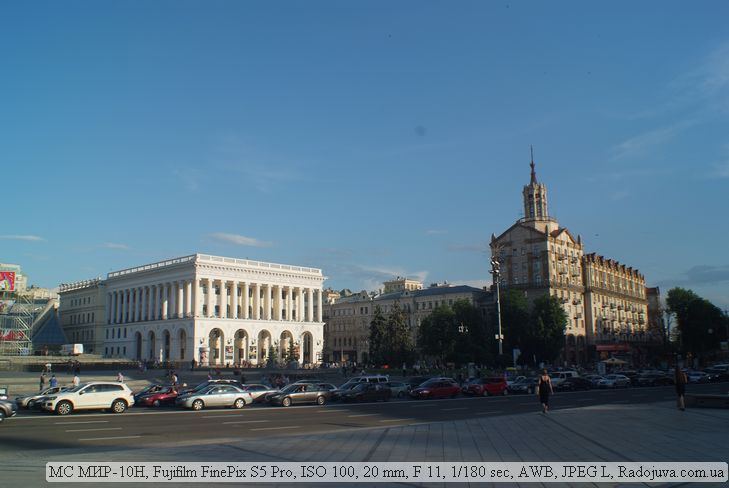
Sample photo on Mir-20N
When you first take the lens, the convex front lens, which has a wide edging that resembles a lens hood, attracts attention very much. The lens is somewhat similar to the legendary Nikkor 14-24mm F2.8. The front lens cap is also convex. The cap is simply snugly fixed to the lens, without clamps.
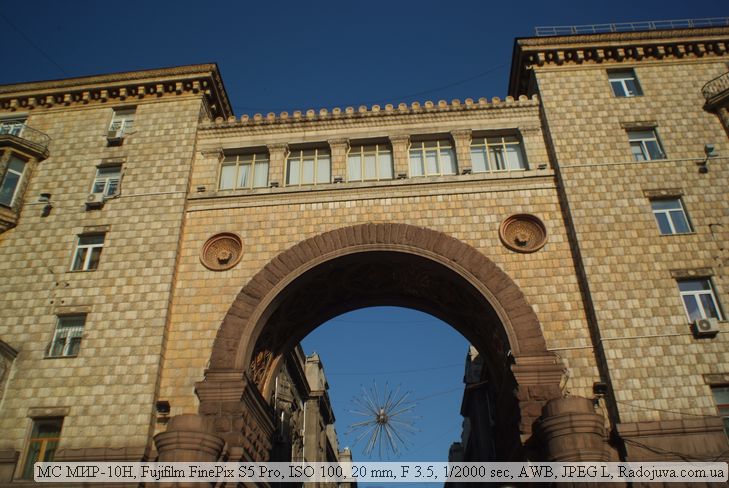
Sample photo on Mir-20N
Basic information about MS MIR-20N F3.5 20mm for the photographer
- The focusing of the lens is very smooth, even slightly tight. Due to the fact that the front lens forms a kind of hood, the focusing ring remains sandwiched between the camera body and the hood. It was not very convenient for me to focus. But the focus ring rotates 320 degrees, thus providing very precise focusing. When focusing, the front lens does not rotate, and the lens unit with the front lens extends half a centimeter relative to the camera.
- The lens aperture is only F / 3.5. This is a low aperture ratio. But wide-angle is often used for landscapes, and there’s a big aperture need not. I do not think that aperture plays a key role in this lens.
- The lens MC MIR-20N shows the depth of field for each aperture value. My copy can close the aperture down to f / 22.0. “Infinity” for the lens starts from 2 meters on the focusing scale.
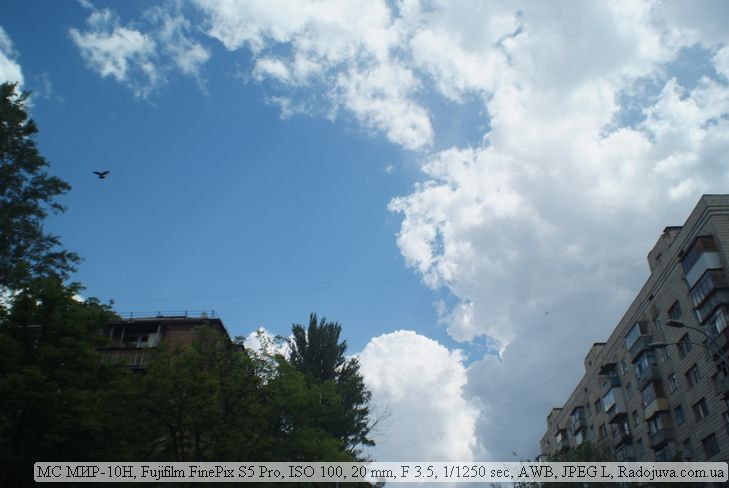
Example photo on the Mir-20N 3.5 20mm MS
- To install the filter on my copy, you need an additional ring, which is screwed into the thread in front of the lens. This imposes restrictions on the use of filters, also, most likely at full frame due to the additional ring and filter, vignetting may deteriorate. There are different versions of the MIR-20, some do not support the installation of filters in front of the lens at all, some use filters that are installed near the rear of the lens group. The problem with the filter is due to a very strongly convex front lens.
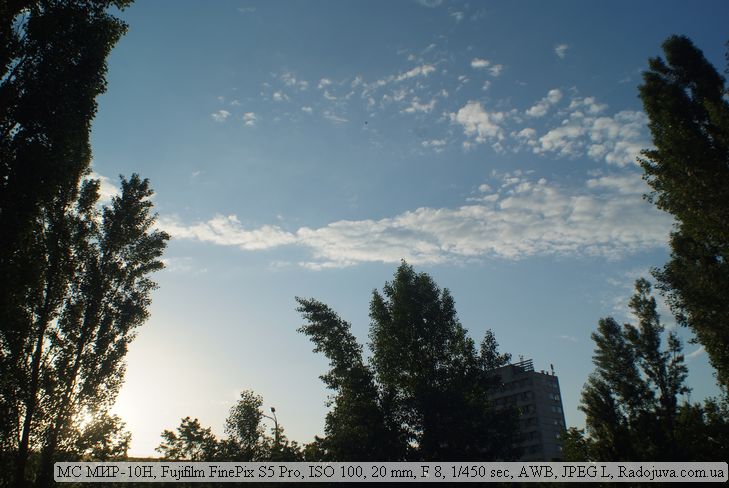
Example photo on the Mir-20N 3.5 20mm MS (in the left corner, the sun is in the frame)
- The lens is very well assembled. Iron and glass. The first two digits of my lens number are 83. This means that the lens was most likely made in 1983. 30 years have passed, and he continues to work.
- On Nikon's APS-C cameras, by virtue crop factor, EGF Mir-20N lens will be 30mm (20 * 1,5), and 30mm is no longer a super wide angle. For APS-C Canon EGF will be 32mm (20*1.6)
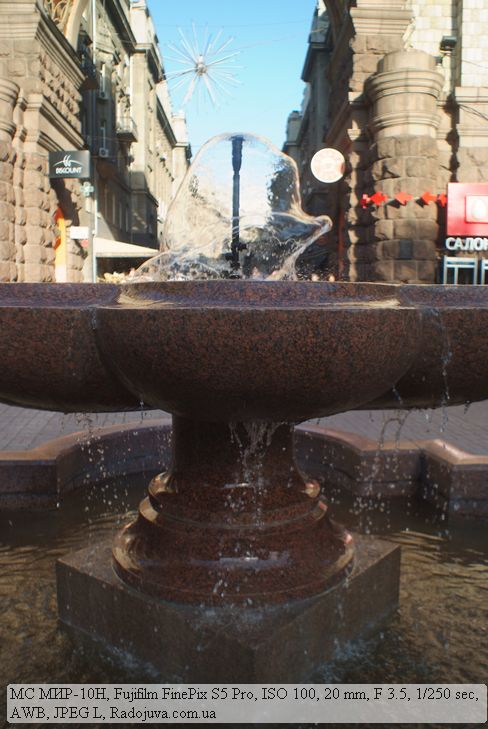
Example photo on the Mir-20N 3.5 20mm MS
- They are not afraid of manual focus control, since due to the fact that the Mir-20N is an ultra-wide angle, the focus ring has to be twisted very rarely, and in 90% of cases the lens is focused on infinity.
- An unusual property of Mir-20N is the minimum focusing distance, which is only 18 centimeters. This is a very good indicator, with the help of such MDF you can experiment with perspective by shooting small objects, flowers, etc. MS MIR-20N has one of the shortest focusing distances among lenses of this class. Even the legendary Nikon 20mm f / 2.8 NIKKOR AI-s has an MDF of 25 cm. True, Carl Zeiss Jena Flektogon 20 mm f / 4 has 16 cm of MDF and much better image quality.
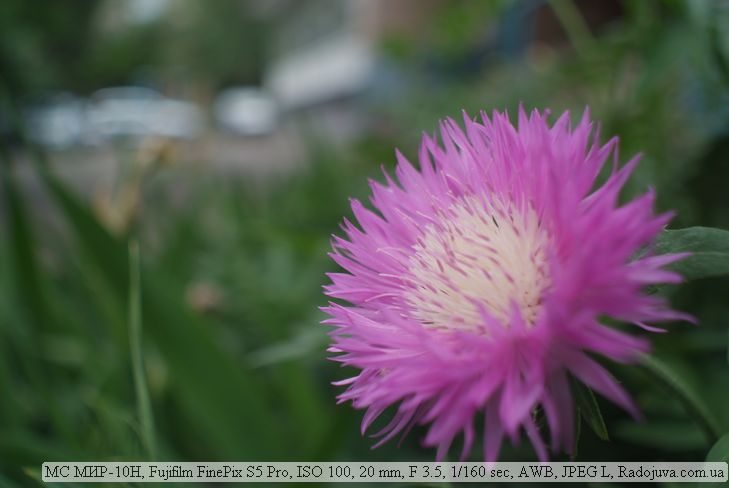
Sample photo on Mir-20N
Image quality
The picture quality is normal. The lens sometimes catches hares, in general, the backlight is poorly tolerated. Most likely, the non-MC version is much worse than my MC version. Doesn't spoil the colors. Most importantly, the lens has a distortion, but very small, for a lens of this type. Sharpness in the center, indeed, is already at F3.5, but even on my cropped matrix at the edges of the frame, the sharpness clearly falls. Sharpness should have been much better. Perhaps I came across not the best instance.
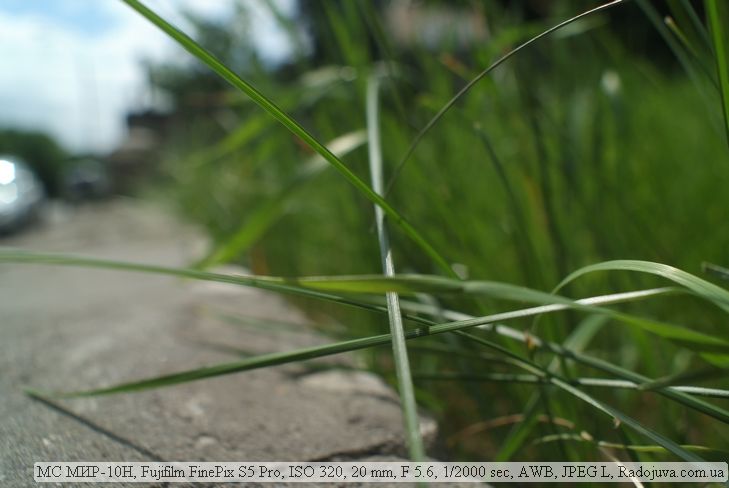
Sample photo on Mir-20N
Sample Photos
All photos in this review were taken on camera. S5 Pro (with Nikon F mount mount) without processing. JPEG L, size compressed to 2048 * 1500 with 80% quality and imprinted data from EXIF. It’s a pity, I don’t have a full shot to drive the Mir-20N MC.
Personal experience:
On cropped cameras, ultra-wide-angle lenses, including Mir-20N, lose their “super wide-angle” and become ordinary “wide-angle”. Therefore, I do not recommend using old wide angle lenses on modern cropped cameras. Of course, Mir-20n will be of much greater interest on full-frame cameras. Cropped, native kit lens 18-55 (e.g. Nikon 18-55mm f / 3.5-5.6G ED AF-S DX Zoom-Nikkor) will give a wider viewing angle than Mir-20N, with the same aperture. Although, for some tasks, the World-20N is quite suitable. You can still look away Mir-73N 20mm F2.8 MS (with the same viewing angles) and Zenithar 16mm F2.8 MC Fisheyewhich gives an unusual fisheye picture. In general, MC Mir-20N can be bought at least for the sake of its unusual appearance, and the lens is quite cheap. Lens modification with M42 thread and without multi-coating - Mir-20M, turned out to be very unsuccessful at work.
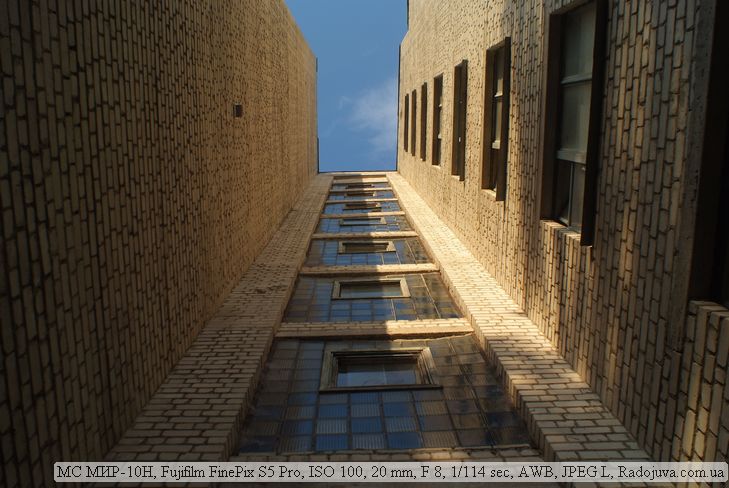
Example photo on the Mir-20N 3.5 20mm MS
Catalog modern brand lenses 'Zenitar' и 'Helios' can look at this link.
Comments on this post do not require registration. Anyone can leave a comment. Many different photographic equipment can be found on AliExpress.
Conclusions:
MC MIR-20N is an interesting vintage lens that gives excellent sharpness in the center, loses sharpness at the edges of the frame. One of the few Soviet lenses that creates a really wide angle of view on cropped cameras.
Material prepared Arkady Shapoval. Training/Consultations | Youtube | Facebook | Instagram | Twitter | Telegram

















How handsome he is!
Who knows, maybe a poll will appear on the cutest Soviet lens!))
I do not plan such a survey.
this is a joke)
And in FIG this poll? The observed lens is clearly worse than the one that soon replaced it at the conveyor (see A.Sh. review about World 24N). I think if the Union had not collapsed, there would have been another World that would have been equal to Nikon's 35, but would have been 20.
I have Mir20 for M42 thread. Graduation of the Krasnogorsk plant. Filters included, screw onto the back of the lens. There is no thread on the front at all. The lens is larger than the World 20n. and heavier.
The lens is VERY sharp with bright, "sharpened" color reproduction. Despite the absence of MC enlightenment, the counter-illumination from the sun in it is extremely small. Considering the very wide capture angle on a 35mm camera, the sun is very often in the frame, but hardly interferes.
The peculiarity of this lens is in the increased filling of the edges, closer to the “fish eye” effect. much more. than Flectogon 2/20. I see it as a means of expression, but for technical photography it is not always suitable. I filmed with both Mir and Flektogon. Practice LTL. And I give preference for sharpness, brightness. expressiveness of the picture MIRu 20. Flektogon was much more “gray”, inexpressive. I shot it on film, of course.
Therefore, there could be no digital correction.
I think the lens is one of the best 20k.
Thank you for sharing the information.
You will be able to look around the lens if you know the typo “... and the lens unit with the front lens moves out aa (typo) half a centimeter relative to the camera ...” (:
Thanks, corrected.
I turned the focus on World 20n with great difficulty, and noted that the rear lens was moving out. Not mixed up?
I choose between Mir-20 and Mir-73. In the first, the aperture 3.5 confuses, in the second - the Ukrainian assembly. Despite the difference of 400 UAH (1200 and 1600, respectively), the CAM seller recommends taking the twentieth. In addition, I myself bought an Arsat 80-200 and saw how weakly it was assembled in comparison with Granite-11.
Help me to understand. Great for overshooting aloof, the aperture is in aperture (2.8 versus 3.5) and is the Ukrainian assembly of this particular lens really deplorable?
Thank you))
Aperture is not fundamental. The assembly and its quality depends directly on your copy.
And what? Choose a better assembled 20th
As for the assembly (both cameras and optics - Soviet and post-Soviet): it is preferable to either early (before 1970 1975), or from 1987 (state acceptance) to 1991 (before the collapse of the USSR).
I agree. There are, of course, unsuccessful specimens, but ... extremely rare. State acceptance and Quality Mark - worked. Especially in the first five years ...
Since then, I have had three cameras and five lenses. Like new. There are no comments on the assembly. There is also FSHU-5 (an iron tripod for photography and cinema - for 40 rubles). They are many times stronger than the current ones, and nothing so very important is not worse ... It stands confidently with 5 kg even on linoleum, even on ice, even on a boulder-stone, even on sand ...
I didn’t really like it, nothing unusual photo like 18-55 kit Nikon. I personally wouldn’t buy it, I just got it
I took this lens from a colleague to play. Used the adapter M42 / N. I have a D7000. I liked the bokeh in it, it is very hard to sharpen. I wanted to take a photo session with him, but alas, I realized that nothing will work out, I am rooted in it.
I bought it. 1986. Spilena jump rope, but it does not interfere. Focusing is really hard. In the first few photographs at the bottom of the frame there are gray flares, as if the petals of the diaphragms had shone, but (!!) the sun was behind. Not even on the side.
In general, I like it, only the small number of aperture values confuses.
The lens is good. And perfectly holds the blow. My World fell with the zenith bolted to it from one and a half meters. Fell on the edging. The edging is bent, but everything works. And I got it for a few hundred rubles after a similar fall of the Flektogon Twenty - everything jammed nafig and I can't even untwist it.
I'd like a review on "World 47"
Thank you very much for your reviews. Thanks to them, I was still able to decide on the purchase of the camera;)
Hello Arkady, tell me please, is it possible to put this lens on Nikon on the lens there is an inscription machine
Hello! Tell me, please, what can be taken from inexpensive lenses for shooting architecture and landscapes? on canon 40D Just a budget is extremely small, and soon go on a trip.
With such a rating and PR, it has long been possible to collect on a full-format camera
What are you talking about?
> SSA
I didn’t really like it, nothing unusual photo like 18-55 kit Nikon. I personally wouldn’t buy it, I just got it
Compared under the same conditions? For example, I am very pleased with my MIR-20H. I compared the picture with the whale 18-55 - on the WORLD the picture is much juicier. And softer. If the sky is leaden, pre-storm - so it is also really lead in the photo ...
I didn't feel any problems with focusing, in fact, for landscapes, the truth is more often at the “infinity” mark ...
MIR-20H. The lens is in working condition, but the focus ring rotates very tightly in the range of 1 m. - infinity. I suppose the grease is thickened in 1985 anyway. I ask for advice: where can I carry out preventive maintenance, or can I disassemble, clean and lubricate it myself?
21n0n,.03.03,,3,n,.,, ‘0+….3…………………0-3333,, .,..,,,
Arkady, good night. And what manual shirik fix would you recommend for a full frame?
For example Distagon T 25mm f2.8
I wanted to buy MS Mir-20N. He has his own soul which others do not have, but that is not the point. At 42 mount there are rumors on the Internet that you need to wind the factory filter. If this is not done, then there will be no infinity, well, or the image will not be very sharp. But what about the N mount? There seems to be no where to wind the filter onto the rear lens. Or doesn’t you need such a filter in the version for such a boy?
All photos are signed “MC Mir-10N” :)
First of all - Arkady.
When editing your review article about MC MIR-20N F3.5 20 mm, do not forget to insert that the monitored lens was not accidentally taken out of production (the process of introducing a width-replacement to the conveyor began somewhere in 1985-87) and was replaced for 24N. This one is much lighter and sharper. There are no other shortcomings either. One thing that's missing is width, especially today when used with a cropped camera. In fact, he is no longer shirik - almost pure fifty dollars.
It was not replaced by Mir-24N at all, but by MS Mir-73N, just the same FR, only a higher aperture ratio and a new enlightenment. In the same way, they planned to replace Mir-20M with Zenitar 2.8 / 20, but it didn't work out - the Union collapsed and no one needed photographic equipment ...
The lens of Mir-20 Avtomat was accidentally caught for ridiculous money. Productions of "Arsnal", of course, and, of course, not MS. 1981 release. The front part is one-to-one like that of the MC Mir-20N, the rear, of course, is different, without a diaphragm ring and with a bayonet for Kiev-10, -15. The lens was lying, lying, did not wait for the worker Kiev-15 and went into a mess. The tail was replaced with the M42 ordered from the turner, the diaphragm ring was installed (however, it was possible to graduate it by drawing a scale very conditionally, the stroke was very short at the ring). Now I install it through an adapter on my cropped Canon and am ready to subscribe literally under every word in your, Arkady, review. Sharp in the center, loss of sharpness in the corners and at the edges of the frame (even cropped), slight distortion, visually expanding the space, excellent bokeh ... There are much more serious lenses in the set, but this one pleases. Even on cloudy days, even on sunny days. The main thing is not to place important subjects at the edges of the frame and not to direct the lens itself against the bright sun - the glare will be accurate, and if the aperture is covered, then it will also be pentagonal. I made a semblance of a homemade hood from a black plastic folder - there is a sense, there are fewer rabbits, but still, on the film Canon, the lens pleased much more - there is no such chromaticity, and the angle! This is the main thing for what it is needed. Well, or shock the audience with a strange lens. I don’t know about you, but here they look at a photographer with a DSLR and Mir-20 with aggression - they’re afraid ...
Judging by the photo of the diaphragm, it has not 6 petals, as written at the beginning of the article, but only 5.
But there is still this lens under the Kiev plug seems to be called the world 20 machine, would you consider it successful or not? there’s just a redone version for carving, I’ve thought about it